
Hawks are birds of prey of the family Accipitridae. They are very widely distributed and are found on all continents except Antarctica.

Falconry is the hunting of wild animals in their natural state and habitat by means of a trained bird of prey. Small animals are hunted; squirrels and rabbits often fall prey to these birds. Two traditional terms are used to describe a person involved in falconry: a "falconer" flies a falcon; an "austringer" flies a hawk or an eagle. In modern falconry, the red-tailed hawk, Harris's hawk, and the peregrine falcon are some of the more commonly used birds of prey. The practice of hunting with a conditioned falconry bird is also called "hawking" or "gamehawking", although the words hawking and hawker have become used so much to refer to petty traveling traders, that the terms "falconer" and "falconry" now apply to most use of trained birds of prey to catch game. Many contemporary practitioners still use these words in their original meaning, however.
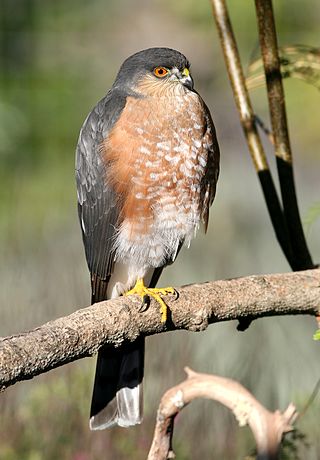
The sharp-shinned hawk or Northern sharp-shinned hawk, commonly known as a sharpie, is a small hawk, with males being the smallest hawks in the United States and Canada, but with the species averaging larger than some Neotropical species, such as the tiny hawk. The taxonomy is far from resolved, with some authorities considering the southern taxa to represent three separate species: white-breasted hawk, plain-breasted hawk, and rufous-thighed hawk. The American Ornithological Society keeps all four variations conspecific.

Cooper's hawk is a medium-sized hawk native to the North American continent and found from southern Canada to Mexico. This species is a member of the genus Accipiter, sometimes referred to as true hawks, which are famously agile, relatively small hawks common to wooded habitats around the world and also the most diverse of all diurnal raptor genera. As in many birds of prey, the male is smaller than the female. The birds found east of the Mississippi River tend to be larger on average than the birds found to the west. It is easily confused with the smaller but similar sharp-shinned hawk.

The red-tailed hawk is a bird of prey that breeds throughout most of North America, from the interior of Alaska and northern Canada to as far south as Panama and the West Indies. It is one of the most common members within the genus of Buteo in North America or worldwide. The red-tailed hawk is one of three species colloquially known in the United States as the "chickenhawk", though it rarely preys on standard-sized chickens. The bird is sometimes also referred to as the red-tail for short, when the meaning is clear in context. Red-tailed hawks can acclimate to all the biomes within their range, occurring on the edges of non-ideal habitats such as dense forests and sandy deserts. The red-tailed hawk occupies a wide range of habitats and altitudes, including deserts, grasslands, coniferous and deciduous forests, agricultural fields, and urban areas. Its latitudinal limits fall around the tree line in the subarctic and it is absent from the high Arctic. Generally it favors varied habitats with open woodland, woodland edge and open terrain. It is legally protected in Canada, Mexico, and the United States by the Migratory Bird Treaty Act.

The Accipitrinae are the subfamily of the Accipitridae often known as the "true" hawks, including all members of Accipiter and the closely related genera Microspizias, Erythrotriorchis, and Megatriorchis. The large and widespread genus Accipiter includes goshawks, sparrowhawks, the sharp-shinned hawk and others. They are primarily woodland birds that hunt by sudden dashes from a concealed perch, with long tails, broad wings and high visual acuity facilitating this lifestyle. In light of recent genetic research, the kites of the traditional subfamily Milvinae may also belong to this group.
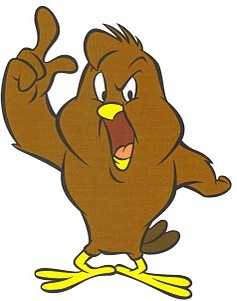
Henery Hawk is an American cartoon character who appears in twelve comedy film shorts produced in the Looney Tunes and Merrie Melodies series. His first appearance is in the 1942 theatrical release The Squawkin' Hawk, which was directed by Chuck Jones and produced by Leon Schlesinger. Henery's second screen appearance, one directed by Robert McKimson, is in Walky Talky Hawky (1946), which also features the characters Foghorn Leghorn and Barnyard Dawg in their first cartoon roles. The last Warner Brothers theatrical short to showcase the little chickenhawk is the 1961 release Strangled Eggs in which he co-stars again with Foghorn Leghorn as well as with another popular character of that period, Miss Prissy. Following that production, Henery continued to be seen periodically in other animated presentations such as The Looney Tunes Show and Looney Tunes Cartoons.
Chickenhawk may refer to:
The fauna of Maine include several diverse land and aquatic animal species, especially those common to the North Atlantic Ocean and deciduous forests of North America. Some of these creatures' habitats has been reduced or fully removed.

Walky Talky Hawky is a 1946 Warner Bros. Merrie Melodies theatrical short directed by Robert McKimson. The cartoon was released on August 31, 1946, and features Henery Hawk and Foghorn Leghorn. This is the first appearance of both Foghorn Leghorn and the Barnyard Dawg.

The Foghorn Leghorn is a 1948 Warner Bros. Merrie Melodies cartoon directed by Robert McKimson. The cartoon was released on October 9, 1948, and features Foghorn Leghorn, Henery Hawk and the Barnyard Dawg.
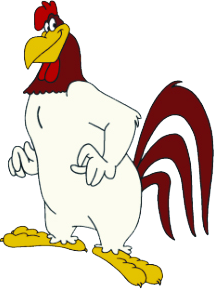
Foghorn Leghorn is a cartoon rooster who appears in Looney Tunes and Merrie Melodies cartoons and films from Warner Bros. Animation. He was created by Robert McKimson, and starred in 29 cartoons from 1946 to 1964 in the golden age of American animation. All 29 of these cartoons were directed by McKimson.

Crowing Pains is a 1947 Warner Bros. Looney Tunes cartoon directed by Robert McKimson. The cartoon was released on July 12, 1947, and stars Henery Hawk, Sylvester, Foghorn Leghorn and the Barnyard Dawg. This is McKimson's first short to feature Sylvester.

You Were Never Duckier is a 1948 Warner Bros. Merrie Melodies cartoon directed by Chuck Jones. The cartoon was released on August 7, 1948, and stars Daffy Duck and Henery Hawk.
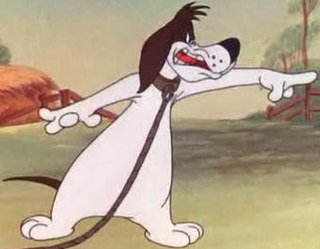
Barnyard Dawg is a Looney Tunes character. A feisty anthropomorphic basset hound, he is a friend and the archenemy of Foghorn Leghorn. He was created by Robert McKimson, who also created Foghorn, and was voiced by Mel Blanc. Dawg also feuds with other enemies as well like Henery Hawk, Daffy Duck and Sylvester. He appeared in 23 Golden Age–era Warner Bros. shorts.
Strangled Eggs is a Warner Bros. Merrie Melodies cartoon short directed by Robert McKimson. The cartoon was released on March 18, 1961, and features Foghorn Leghorn, Henery Hawk and Miss Prissy. The voices are performed by Mel Blanc. This was the only cartoon to star both Miss Prissy and Henery Hawk.
The Leghorn Blows at Midnight is a 1950 Warner Bros. Looney Tunes cartoon directed by Robert McKimson. The cartoon was released on May 6, 1950, and features Foghorn Leghorn, Henery Hawk and the Barnyard Dawg.
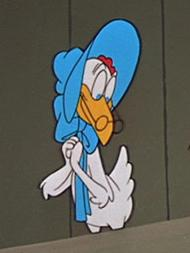
Miss Prissy is a fictional character in Warner Bros. cartoons. She is typically described as an old spinster hen, thinner than the other hens in the chicken coop, wearing a blue bonnet and wire-rimmed glasses. She is often mocked by the other hens, who describe her as "old square britches".
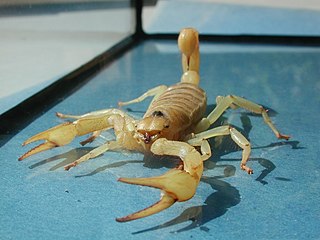
The fauna of the U.S. State of Nevada is mostly species adapted to desert, temperature extremes and to lack of moisture. With an average annual rainfall of only about 7 inches (180 mm), Nevada is the driest – and has the largest percentage of its total area classified as desert – of all states in the United States. Two-thirds of the state is located within the largest desert on the North American continent, the Great Basin Desert, while the lower one-third is the Mojave Desert.

The Eurasian goshawk is a species of medium-large bird of prey in the family Accipitridae, a family which also includes other extant diurnal raptors, such as eagles, buzzards and harriers. As a species in the genus Accipiter, the goshawk is often considered a "true hawk". The scientific name is Latin; Accipiter is "hawk", from accipere, "to grasp", and gentilis is "noble" or "gentle" because in the Middle Ages only the nobility were permitted to fly goshawks for falconry.















